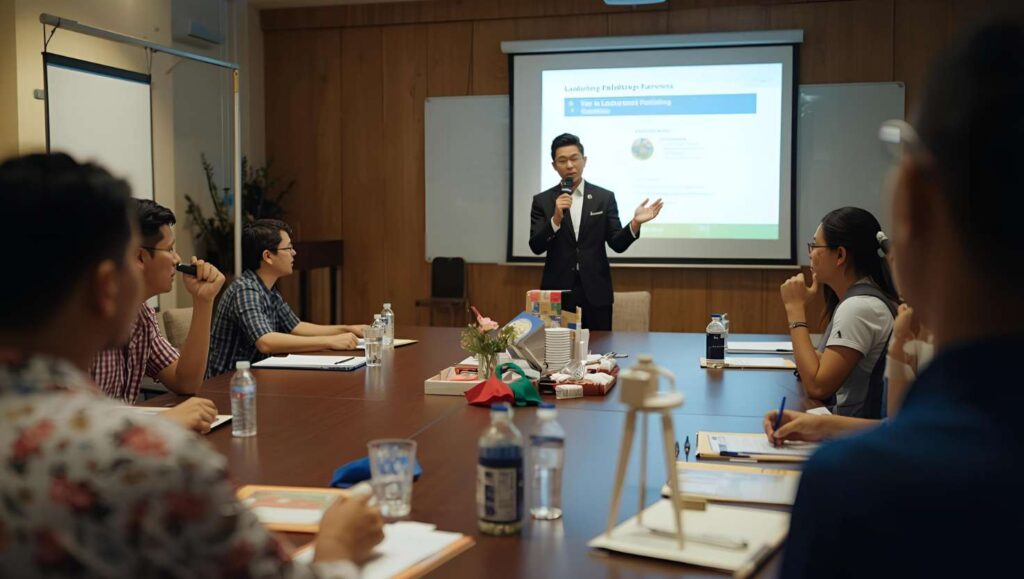Leadership is not theory. It’s lived every day—in the decisions you make, the conversations you lead, and the example you set.
In the last 20 years, I’ve trained supervisors in factories, managers in government agencies, and executives in some of the biggest companies in the Philippines and abroad. Over the years, I’ve conducted leadership training in Metro Manila, Laguna, Batangas, Cavite, Bulacan, Pampanga, and many other provinces—working with leaders at every level, from first-time supervisors to senior executives.
I’ve seen brilliant leaders inspire loyalty with just a few words, and I’ve also seen talented people fail because they never learned the skills that truly move people.
I remember working with a newly promoted supervisor in a manufacturing plant. Technically, he was brilliant—he knew every machine, every process. But when conflict erupted on the floor, he froze. He tried to avoid the issue, hoping it would go away. Instead, the small tension grew into a bigger rift that affected productivity for weeks. What he lacked wasn’t knowledge. It was the leadership skill of turning conflict into clarity.
On the other hand, I once coached a young manager in a BPO company who struggled with confidence. She would second-guess herself in meetings and often kept her ideas to herself. After learning how to communicate with clarity and practice confidence under pressure, she didn’t just gain respect from her team—she became one of the most trusted leaders in her department.
Stories like these remind me: leaders don’t grow by accident. They grow by practicing the right skills, in the right order. And those skills are what we call leadership training topics.
What Are Leadership Training Topics?
Leadership training topics are the focused skills, behaviors, and mindsets that leaders practice to meet real-world challenges. They are not abstract theories. They are practical shifts that help leaders guide their teams, solve problems, and deliver results.
Think of them as the “building blocks” of leadership. Each topic represents one essential area where leaders can grow—like communication, decision-making, or conflict resolution. When leaders train on these topics, they don’t just gain knowledge. They practice actions that make them credible and effective in the workplace.
In my years of facilitating programs across Metro Manila and the provinces, I’ve seen that the most powerful leadership training topics share three qualities:
- They meet a pressing need. For example, a manager who struggles with giving feedback doesn’t need a lecture on leadership theory—he needs a simple way to coach without fear.
- They are easy to apply. A good training topic can be practiced immediately in the next meeting, conversation, or project.
- They create visible change. When applied well, they don’t just make leaders feel better—they make teams perform better.
That’s why I prefer to frame leadership training topics not just as skills to learn but as shifts to master. Leadership is about moving from one state to another:
- From confusion → to clarity
- From control → to coaching
- From firefighting → to foresight
- From managing → to leading
When training focuses on these shifts, leaders don’t just understand leadership—they live it.
Why Leadership Training Topics Matter Now
The workplace is changing faster than ever. Artificial intelligence is reshaping jobs, hybrid setups are redefining teamwork, and employees are experiencing record levels of stress and burnout. In this environment, leadership can no longer rely on old formulas or static skills.
A few years ago, a manager could get by with strong technical knowledge and a firm hand. Today, that same approach can backfire. Teams expect clarity, empathy, and adaptability. They want leaders who can coach, not just command. They want direction without micromanagement.
This is why leadership training topics matter now more than ever. They give leaders the tools to:
- Navigate uncertainty with confidence
- Keep people engaged, even in remote or hybrid settings
- Turn conflict and stress into opportunities for growth
- Build trust before targets, so results are sustainable
In my workshops across Metro Manila and nearby provinces, I’ve seen the difference. One company invested in training supervisors on how to run short, effective team huddles. Within weeks, productivity rose—not because people worked longer hours, but because their meetings had more clarity and less confusion.
When leaders grow, teams don’t just follow. They flourish.
And the best way to help leaders grow is to focus on the right training topics—the ones that turn knowledge into practice and practice into transformation.

12 Essential Leadership Training Topics (With Shifts)
There are countless skills people associate with leadership, but only a few create the real shifts that teams can feel every day. These topics are not just “lessons” in a training manual—they are practices that change how leaders show up, speak up, and step up.
Here are 12 essential leadership training topics I’ve seen transform organizations. Let’s start with the first four.
1. Clarity Over Confusion (Communication Skills)
A leader’s message should move people, not muddle them. Too often, miscommunication leads to wasted hours, repeated mistakes, and frustrated employees. Training in communication is not about flowery speeches—it’s about clarity.
One executive I worked with used to send emails so long that his team dreaded opening them. After learning how to communicate in short, structured bursts, he cut meeting time in half and gained the trust of his staff. The shift was simple but powerful: less confusion, more action.
2. Feedback That Fuels Growth (Coaching & Mentoring)
Many leaders avoid giving feedback because they fear it will demotivate their people. Others deliver it harshly, causing resentment. A strong training topic teaches leaders how to give feedback that inspires improvement instead of defensiveness.
I recall a supervisor in Pampanga who learned a simple coaching framework: affirm first, address the issue, and agree on next steps. Within weeks, her team became more open, and performance steadily rose. The shift: feedback as fuel, not fire.
3. Confidence Under Pressure (Decision-Making)
Indecision kills momentum. Leaders who hesitate in moments of pressure lose credibility, while those who decide with clarity inspire confidence. Training on decision-making equips leaders to balance data, intuition, and urgency.
In a Cavite workshop, a young manager confessed that he often delayed approvals out of fear of making mistakes. After practicing a structured decision-making tool, he became more decisive—and his team started delivering faster results. The shift: from hesitation to confident action.
4. Conflict Into Clarity (Conflict Resolution)
Conflict in the workplace is not the enemy. Unresolved conflict is. Training leaders to face conflict directly and turn it into constructive dialogue prevents small issues from becoming costly crises.
I once worked with a retail team in Bulacan where two senior staff members had a silent feud. The store manager, after training in conflict resolution, brought them together, clarified misunderstandings, and set new agreements. Sales improved almost immediately. The shift: from avoidance to alignment.
5. Lead the Change (Change Management)
Change is the one constant in every organization—but many leaders resist it or mishandle it. Training in change management helps leaders guide their teams through uncertainty with vision and confidence.
I remember a factory supervisor in Laguna who had to introduce new technology on the production floor. At first, workers resisted, fearing it would slow them down. After the supervisor learned how to frame change as an opportunity, not a threat, the transition became smoother. The shift: from resistance to readiness.
6. Vision That Moves People (Strategic Thinking)
Teams don’t just need instructions. They need direction. Training leaders to think strategically means helping them see beyond daily tasks and paint a picture of the future their teams can rally behind.
A government manager I worked with in Batangas used to focus only on deadlines. After practicing strategic thinking, he began sharing the bigger “why” behind projects. His team’s morale lifted because they saw how their small tasks connected to a larger mission. The shift: from tasks to trajectory.

7. Trust Before Targets (Team Building & Trust)
Trust is the foundation of high performance. Without it, even the most skilled teams will crumble under pressure. Leadership training must teach leaders how to build trust through consistency, fairness, and transparency.
In Cavite, I trained a group of call center supervisors who struggled with high attrition. Once they learned practical trust-building habits—like keeping commitments, sharing credit, and listening with empathy—their teams became more loyal and less likely to leave. The shift: from compliance to commitment.
8. Accountability Without Fear (Performance Management)
Accountability is often misunderstood as punishment. In truth, it’s about ownership. Training in performance management teaches leaders to set clear expectations and hold people responsible in ways that inspire rather than intimidate.
I once guided a Pampanga executive who struggled with underperformers. After learning to use accountability conversations that focused on solutions instead of blame, she noticed her team stepped up more willingly. The shift: from fear-driven compliance to proud ownership.
9. Inclusion Is Influence (Diversity & Inclusion)
Leadership in today’s workplace means creating space where every voice counts. Training on diversity and inclusion isn’t just about compliance—it’s about unlocking the collective strength of a team.
In Metro Manila, I worked with a tech company where younger employees felt sidelined in decision-making. After training managers on inclusive leadership practices, brainstorming sessions became livelier, and more innovative ideas surfaced. The shift: from exclusion to empowerment.
10. From Stress to Strength (Resilience & Well-being)
Leaders who burn out cannot lead well. Training in resilience equips leaders to manage stress, model healthy habits, and support the well-being of their teams.
I recall a manager in Laguna who was juggling multiple projects and nearing exhaustion. After resilience training, he began setting realistic boundaries and encouraging short recovery breaks for his team. The result? Less turnover and better performance. The shift: from burnout to balance.
11. Serve to Lead (Servant Leadership & Empathy)
The strongest leaders are often the most humble. Training in servant leadership helps managers shift from authority-driven to service-driven leadership.
In Bulacan, a school principal I coached started practicing “leading from behind”—asking teachers what support they needed rather than dictating solutions. Morale rose, and teachers began to step up with more initiative. The shift: from command to care.
12. Future-Ready Leaders (Adaptability in the AI Era)
With AI, automation, and new technologies changing industries rapidly, leaders need adaptability more than ever. Training in this area ensures leaders stay relevant and confident in uncertain times.
In Cavite, I met a small business owner who feared that digital tools would overwhelm his older staff. Through adaptability training, he reframed technology as an ally. His team embraced new systems, and productivity soared. The shift: from fear of the future to confidence in it.
How to Choose the Right Topics for Your Team
Not every team needs the same training at the same time. A start-up manager in Manila may struggle with clarity in communication, while a government supervisor in Pampanga may need stronger skills in conflict resolution. The key is not to cover everything but to focus on the next shift that matters most.
Here’s a simple way to choose the right leadership training topics for your team:
→ Start with the biggest pain point. Ask: What is slowing us down right now? The answer usually points to the most urgent training need.
→ Match topics to real behaviors, not just ideals. Instead of saying “We need better leadership,” be specific: We need leaders who give feedback without fear.
→ Prioritize one or two topics at a time. Trying to cover too much dilutes learning. Focus on the skills that will make the biggest difference in the next 90 days.
→ Measure shifts, not just sessions. Don’t ask “Did we attend the training?” Ask “What changed in how we lead?”
In my experience, the most effective organizations are those that treat leadership training as a series of shifts, not a single event.
Common Mistakes in Leadership Training
Even the best intentions can fail if leadership training is not designed well. Over the years, I’ve seen organizations invest time and money in programs that looked good on paper but produced little change. Here are the most common mistakes:
1. Turning training into a laundry list.
Some companies pile on every possible topic in one workshop—communication, decision-making, conflict, strategy—thinking more is better. But leaders leave overwhelmed and unsure where to begin. Focus creates impact.
2. Making it theory-heavy, practice-light.
PowerPoint slides filled with definitions don’t transform leaders. Action does. Leaders need role plays, case examples, and practical tools they can use in their next meeting, not just textbook models.
3. Ignoring culture and context.
Leadership is not the same everywhere. In the Philippines, values like pakikipagkapwa (shared humanity) and bayanihan (community spirit) are powerful drivers of trust and teamwork. Training that ignores these realities feels foreign and rarely sticks.
4. Measuring attendance, not behavior.
Many HR teams check if people attended training but never check if behavior actually changed. True success is seen in improved decision-making, healthier team dynamics, and stronger results—not just certificates of completion.
When organizations avoid these mistakes and design training around real shifts, leaders don’t just “attend.” They transform.

Frequently Asked Questions About Leadership Training Topics
1. What is the most important leadership training topic today?
It depends on your team’s needs, but if I had to choose one, it would be communication with clarity. In hybrid and fast-changing workplaces, leaders who can communicate clearly build trust, reduce confusion, and move teams forward.
2. How often should leaders train?
Leadership training is not a one-time event. The most effective approach is continuous development—short, focused programs every few months, supported by coaching and real-world application. Think of it like going to the gym: consistency matters more than intensity.
3. Which topics work best for first-time managers?
New managers often struggle with three areas: giving feedback, building trust, and decision-making. Training them on feedback that fuels growth, trust before targets, and confidence under pressure helps them transition smoothly from individual contributor to team leader.
4. How can small organizations implement leadership training without a big budget?
Start simple. Choose one high-impact topic, like communication or accountability, and run short sessions or peer-learning huddles. Many of my clients in Laguna and Batangas began with practical, low-cost workshops that created lasting shifts in culture.
5. Can leadership training really change behavior?
Yes—when it’s designed around practice, not just theory. I’ve seen managers in Pampanga and Cavite transform their leadership style after applying even one powerful shift. The key is training that goes beyond awareness and into action.
Next Steps
Leadership isn’t about mastering everything. It’s about mastering the next shift your team needs. One leader may need to turn conflict into clarity. Another may need to build trust before targets. Another may need the courage to make confident decisions under pressure.
The truth is, leadership training topics are not just items on a checklist. They are doorways to transformation. Each topic you choose and practice creates a visible difference in how your team thinks, works, and grows.
I’ve seen this in Metro Manila, Laguna, Batangas, Cavite, Bulacan, Pampanga, and across the Philippines. When leaders grow, teams don’t just follow—they flourish.
If you’re ready to take your team to the next level, explore my Leadership Training Workshops. Whether you’re building first-time supervisors or preparing senior managers for bigger challenges, the right training topics can unlock the shifts your organization needs most.
Because in the end, leadership is not taught—it’s practiced. And practice begins with the right topic.
